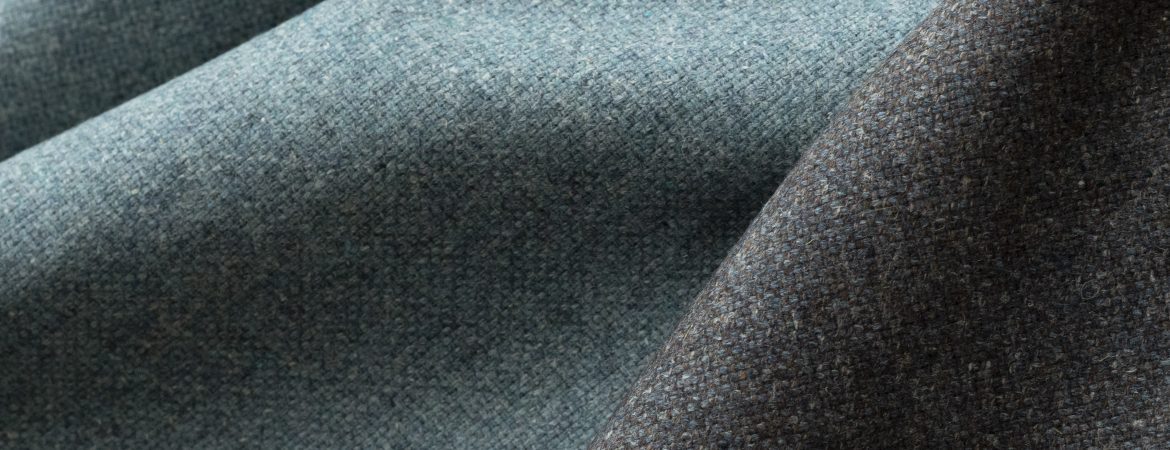
Post-consumer recycled fabrics: a sustainable revolution in upholstery fabrics
FABRAA aims for an optimal balance between price, quality, and sustainability. In the realm of sustainable upholstery fabrics, FABRAA has already taken strides. Our commitment to post-consumer recycled fabrics is a crucial step towards a greener and more responsible textile industry. In this article, we delve deep into what post-consumer recycled fabrics entail and why they are of significant importance for a more sustainable future. We also highlight the distinction between post-consumer and post-industrial textiles, and how FABRAA contributes to this environmentally conscious movement with fabrics like Facet and Forward.
What are post-consumer recycled fabrics?
Post-consumer recycled fabrics are materials derived from used textile products such as old clothing and furniture. This is something we wholeheartedly endorse. Therefore, we emphasize post-consumer recycling, an approach that goes beyond the common post-industrial recycling. The goal is clear: to create textiles from textiles, thus achieving a circular approach to sustainability.
This recycling method contributes to reducing textile waste and minimizes pressure on natural resources. It is not just a step towards a circular economy but also a way to shrink the ecological footprint of the textile industry.
The importance of post-consumer recycling for the textile industry
Post-consumer recycling goes beyond sustainability; it is a necessary evolution for the textile industry. Significant strides must be taken in sustainability, and reutilizing used textile products brings substantial benefits. One of them is a reduction in the waste pile-up. Another advantage is preventing valuable materials from ending up in landfills. This not only contributes to a cleaner environment but also addresses the growing demand for sustainable textile options.
Consumers are fortunately becoming increasingly aware of the environmental impact of their purchases. This makes post-consumer recycling not only an ideological choice but also a savvy business move. It provides textile companies the opportunity to make a positive impact while meeting the rising demand for sustainable products.
Post-consumer recycled fabrics vs. post-industrial textiles
The distinction between post-consumer and post-industrial textiles is crucial in sustainability conversations. Post-industrial textiles come from production waste, such as cut-offs from factories. While a good start, the ultimate goal is post-consumer recycled textiles, directly sourced from consumer end-products, such as worn clothing. Both recycling methods are valuable, but our focus lies on post-consumer recycling. Reusing consumer waste completes the cycle and is the most effective approach to reducing textile waste.
Designing recyclable products
Sustainability begins with design. It is crucial to design a product with recyclability in mind. The objective is not only to reuse materials but also to design products that are easily recyclable.
This practical aspect of sustainable design not only reduces environmental impact but also paves the way for a more efficient recycling process. Minimizing waste and maximizing reusability are core principles contributing to a more sustainable textile industry.
Recycling fabric blends
The ideal scenario would be to recycle mono streams, but due to technical requirements and existing textile streams, this is not always feasible. A notable technological development is the recycling of fabric blends. Many believe that only mono streams of textiles are mechanically recyclable into new yarns, but that is not the case. In places like Prato, there’s an industry with experience in recycling mixed fabrics.
Post-consumer recycled fabrics from FABRAA: Facet and Forward
FABRAA is consistently committed to sustainability. Two excellent examples of how we incorporate post-consumer recycled textiles are our fabrics Facet and Forward.
Forward: stylish and environmentally conscious
Forward, a luxury woven fabric, embraces sustainability by utilizing recycled post-consumer wool. The production process is environmentally friendly, giving previously used woolen products a new lease on life.
Carding, the process of combing wool or other fibers to clean, detangle, and align them for spinning yarn, is used in the textile industry as a preparatory step. During carding, fibers are aligned and rid of impurities, creating a uniform texture suitable for further processing. This technique is also applied in the production process of Forward, resulting in the formation of unique yarn used to create the upholstery fabric. This process sets it apart from other sheared wool yarns and qualities.
While using Forward, some pilling may occur, but this does not affect the durability of this woolen fabric. Each batch is unique, with possible color variations. Forward has a lightly mottled appearance and is available in an extensive and trendy color range.
Facet: sustainability in versatility
Facet, a post-consumer woolen upholstery fabric, is suitable for various upholstery purposes. It follows the same environmentally friendly production process as Forward, giving used woolen clothing, fabrics, and knits a second life.
The yarns for Facet are carded from clothing made of regenerated wool products, creating a unique yarn. The production and finishing process of Facet, like Forward, is carried out by an experienced Italian textile specialist.
Facet undergoes extensive tests for durability and safety, including BS5852 cigarette (part 0) & match (part 1) and EN1021 cigarette (part 1) & match (part 2). This makes Facet not only a sustainable choice but also a safe choice for various applications, including in the project market.
Concrete steps towards sustainability
As a provider of high-quality upholstery fabrics, we place great importance on sustainability in the textile industry. A greener future is undoubtedly achievable! By embracing post-consumer recycling and designing products that are easily recyclable, we are already making a significant difference. Technology is working in tandem with us and is continually evolving, allowing for the recycling of more fabrics, sometimes even blends. This results in beautiful materials. Therefore, it is entirely possible to recycle textiles without compromising on quality and aesthetics. Fortunately, there are plenty of sustainable solutions for the textile and furniture industry.